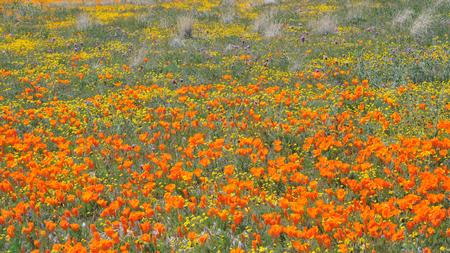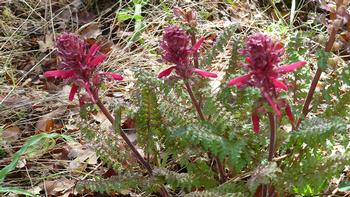Wildflowers are survivors
-
Watching Marin’s hillsides and valleys light up with springtime wildflowers is a visual delight — a farewell to winter and a sign that warmer, colorful days have arrived. California is among of the most floristically diverse regions of the world, and Marin is no exception. Thanks to our abundant, protected open space, temperate climate, and varied topography, we can witness firsthand the profound beauty of spring’s most alluring flowers.
 Field of wildflowers. Courtesy of UC Regents
Field of wildflowers. Courtesy of UC RegentsBut before you button up your lederhosen and head for the hills, let’s take a closer look at why witnessing wildflowers is more significant than it appears.
History of California wildflowers
Native Americans have called California home for 10,000 years. For most of this time they subsisted off our treasure trove of native plants, including willows for baskets, bulbs and corms for food, and herbs for medicine. During these years the hillsides were smothered with wildflowers every spring: shocking orange poppies, milky white lilies, deep purple lupine.
Things changed when the Franciscan missionaries arrived on the scene. It wasn’t that they didn’t like wildflowers; I’m sure they did. But in addition to religion, these newcomers unwittingly brought European weeds with them. Some, primarily grasses and mustards, were used as food sources and animal forage, while others were accidentally introduced into the landscape.
By the early 1800s there were more livestock than people. These animals grazed on the exotic weeds and then cruised around fence-free, spreading seeds for generations to come. Botanists first realized the problem at the turn of the 20th century, when European grasses began their unstoppable march across California. By the 1920s it was game over.
Invasive plants crowd out wildflowers
Weedy, non-native grasses are horticultural thugs. They may cause us to wax poetic as they turn green when it rains, but in reality they crowd out native species, including annual wildflowers, and increase the chance of fire. These invasives reduce the diversity of plants and pollinators, which has a ripple effect on air and water quality and lessens the chance of plant-based industrial and medical discoveries. As if those aren’t enough reasons to thumb our collective noses at invasive weeds, let’s not forget that they just aren’t that interesting to look at. Native wildflower Pedicularis densiflora, or Indian Warrior. Photo: Katie Martin
Native wildflower Pedicularis densiflora, or Indian Warrior. Photo: Katie MartinToday’s wildflowers are tenacious – and some in Marin are rare
Which brings us to today, the cusp of spring. Given the history of their terrain, the wildflowers we see poking up are the ultimate survivors. While it may not be the blanket of color that existed a few hundred years ago, you have to take your hat off to these fighters. Today’s wildflowers have not only out-competed aggressive invaders, but also fire, floods, drought, pesticides, construction and climate change. Clearly, their delicate appearance belies a tenacious will to live.
It’s even more impressive for the rare, endemic species that grow in just one or two tiny areas. For instance, you won’t find the Tiburon mariposa lily anywhere but Ring Mountain. It’s the only place on earth where it grows. The somber-toned checker lily is another endangered flower that only grows in Marin. The threatened Tiburon Indian paintbrush only makes appearances in Marin, Napa and Santa Clara counties.
And the list goes on. Indian warriors, scytheleaf onions, leopard lilies: even their names sound intimidating. Many of these springtime guests only perform in the wild; try to cultivate them at home and you will be sorely disappointed.
There’s no denying that these welcomed annual visitors have earned our respect and admiration.


